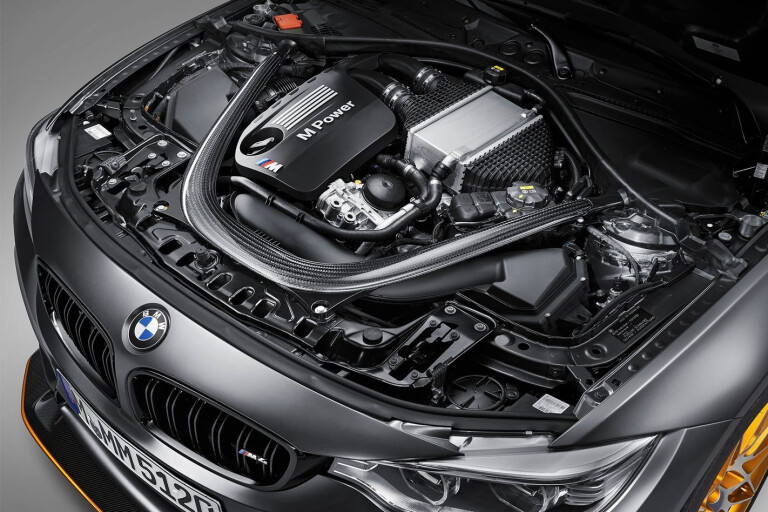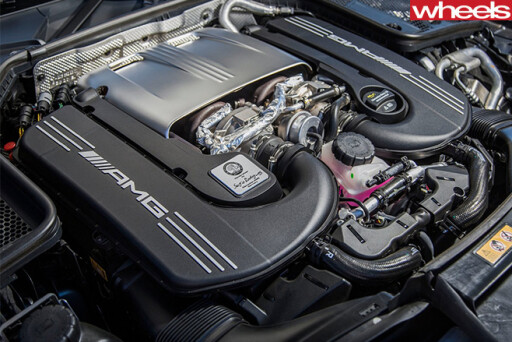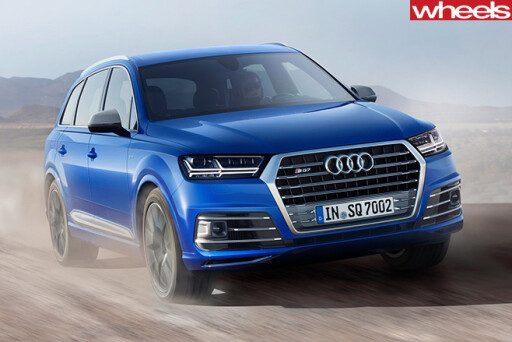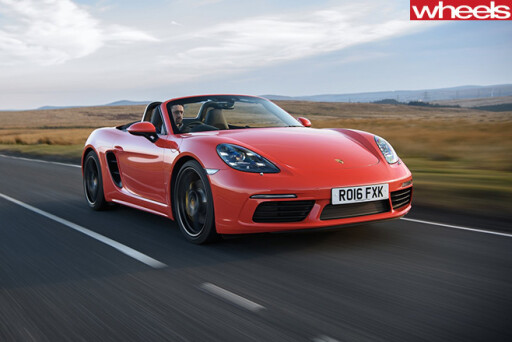
A car without an engine is just a soulless box, and though the future of motoring looks like it will be dominated by electron-powered appliances the good news is that there’s still plenty of exciting machines for us to enjoy in the present day.
Here are some of the more noteworthy engines to make their debut over the past 12 months, and just to show that our low-emissions future might not look so bleak after all, there’s even a hybrid that made the cut.
BMW M4 GTS
3.0-litre twin-turbo inline six petrol
368kW/600Nm
 How does one improve on the already heady performance of the BMW M4? Just add water.
How does one improve on the already heady performance of the BMW M4? Just add water.
Thanks to a clever water injection setup and a few other engine tweaks, BMW’s M-car geniuses have managed to extract a further 51kW more power and 50Nm more torque from the standard M4’s turbocharged 3.0-litre six. Result: a three-tenth reduction in 0-100km/h time to just 3.9 seconds.
How does it work? By spraying a mist of water into the cylinders, the GTS’ engine thus runs cooler and can tolerate an air-fuel mixture that produces more power, but generates far more heat. On top of that, the M4 GTS also scores a lightweight titanium exhaust to help shed pounds and improve engine sonics. Tasty.
Mercedes-AMG C63 S
4.0-litre twin-turbo V8 petrol
375kW/700Nm
 While atmo fiends wept tears of sorrow at the demise of AMG’s joyous 6.2-litre V8, its downsized, turbocharged successor proved that yes, there is in fact a replacement for displacement.
While atmo fiends wept tears of sorrow at the demise of AMG’s joyous 6.2-litre V8, its downsized, turbocharged successor proved that yes, there is in fact a replacement for displacement.
Landing on our shores in the C63 S and AMG GT S, Benz’s new high-performance bent-eight delighted us with its strongman character and cacophonous exhaust crackle.
Developing 375kW of power and 700Nm of torque in the C63 S, this engine might be missing some of the old big-cube 6.3’s charm, but it compensates with near-endless thrust and almost lag-free response.
Mazda CX-9
2.5-litre turbo inline four petrol
170kW/420Nm
 Mazda took a brave punt when it decided to stuff the CX-9’s snout with a turbocharged petrol four-pot. Not just because diesels traditionally make more sense in a large seven-seat SUV, but also because the company’s last turbo petrol SUV, the CX-7, had one hell of a drinking problem.
Mazda took a brave punt when it decided to stuff the CX-9’s snout with a turbocharged petrol four-pot. Not just because diesels traditionally make more sense in a large seven-seat SUV, but also because the company’s last turbo petrol SUV, the CX-7, had one hell of a drinking problem.
But Mazda reckons their petrol-only, turbo-only strategy will pay off for the CX-9 thanks to some clever technology. Tuned to produce the bulk of its 420Nm torque output low in the rev range, like a diesel, the CX-9’s engine avoids having to rev hard and thus keeps thirst at bay.
Does it work? In Wheels comparison testing, the CX-9 impressed us with its ability to drink substantially less than all of its petrol-powered 7-seat rivals – including the top-selling Toyota Kluger
Audi SQ7
4.0-litre triple-turbo V8 diesel
320kW/900Nm
 Taking a 2.3-tonne three-row SUV to 100km/h in under five seconds is no small task, but Audi has found a way to make it happen. Tripping the stopwatch at just 4.9 seconds from standstill to 100km/h, Audi’s SQ7 is one of the quickest means of transporting seven people in one go.
Taking a 2.3-tonne three-row SUV to 100km/h in under five seconds is no small task, but Audi has found a way to make it happen. Tripping the stopwatch at just 4.9 seconds from standstill to 100km/h, Audi’s SQ7 is one of the quickest means of transporting seven people in one go.
And it’s a clever triple-turbocharged diesel V8 that makes it all possible. By using an electrically-assisted turbocharger to deliver positive pressure before the two conventional turbos have spun up, the SQ7’s V8 oiler boasts a wider power and torque band than similarly-sized diesels. Supremely complex, but also extremely fast.
Honda NSX
3.5-litre twin-turbo V6 petrol hybrid
427kW/550Nm
 Honda Australia might be gun-shy on hybrids since cutting the Accord, Civic, Jazz, Insight and CR-Z hybrids from local showrooms, but Mother Nature can breathe easy in the knowledge that there’s still a petrol-electric option from the Big H – the $420,000 NSX supercar.
Honda Australia might be gun-shy on hybrids since cutting the Accord, Civic, Jazz, Insight and CR-Z hybrids from local showrooms, but Mother Nature can breathe easy in the knowledge that there’s still a petrol-electric option from the Big H – the $420,000 NSX supercar.
Marrying a 373kW 3.5-litre twin-turbo petrol V6 with a trio of electric motors (two on the front axle, another assisting the petrol engine at the back), the 2017 Honda NSX is the first hybrid supercar to be sold in Australia, and is capable of both running on battery power alone or blasting to 100km/h in roughly three seconds with all four motors lit up.
Its engine is completely bespoke too, there’s no repurposed Accord V6 lurking under the NSX’s rear deck lid. With a 75-degree V angle to enable a low profile, close-coupled turbochargers, dry-sump lubrication, fully variable valve timing on inlet and exhaust and both direct and port fuel injection, the NSX’s V6 is the most advanced engine ever built by Honda.
Porsche Boxster S
2.5-litre turbo flat four petrol
257kW/420Nm
 Porsche, that bastion of driving joy, isn’t immune to the downsizing trend, and the Boxster was the latest model to make the transition to turbo power for the German sports car specialist.
Porsche, that bastion of driving joy, isn’t immune to the downsizing trend, and the Boxster was the latest model to make the transition to turbo power for the German sports car specialist.
The 718 Boxster also controversially lost a pair of cylinders in the process. Is the Boxster worse off for the loss of a yowling atmo flat six behind the seats? Experience has shown that isn’t the case.
Instead, the Boxster – and the 2.5-litre Boxster S specifically – now boasts substantially more grunt than before. Crucially, the Boxster S’ torque figure jumps by 60Nm – much of it accessible from low in the rev range. It’s more tractable and muscular than before, yet thanks to a variable-geometry turbocharger (a rarity in a petrol performance car) it’s pleasingly lag-free.

COMMENTS